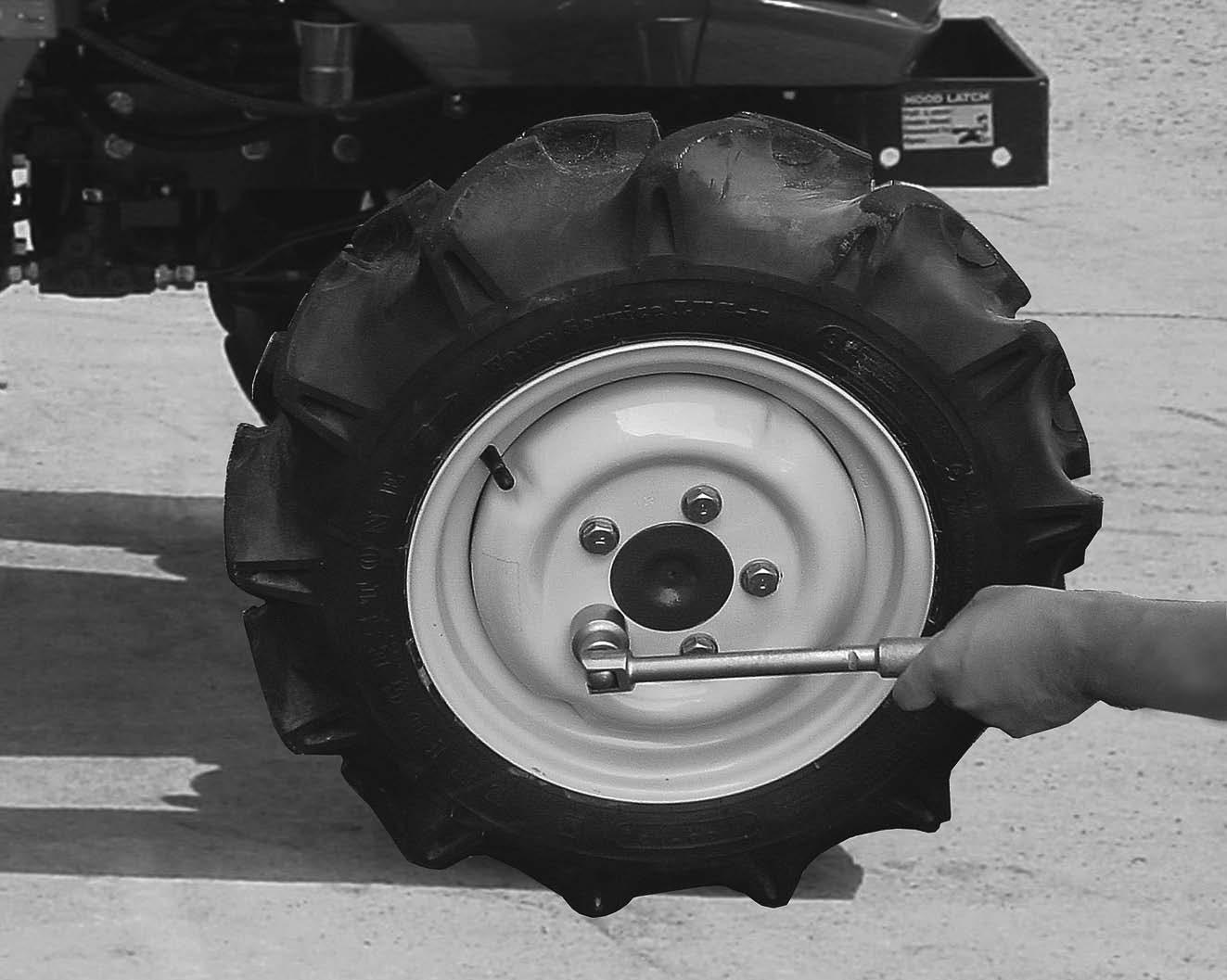
3 minute read
TIRE AND RIM EQUIPMENT
Tire Inflation Specifications
For normal tractor operation use the inflation pressure shown in the tire and wheel chart. The inflation pressure are based on cold inflation pressure recommendations by Tire and Rim Association Inc.
For maximum tractor performance, always adjust the tire pressure within the minimum/maximum range to conform with the actual load on the tires. Under normal conditions, use the minimum pressure rating for general drawbar work. Use the higher pressure rating, up to the maximum, for heavy three point hitch mounted equipment, or heavy front and mounted equipment.
Example A shows the cross section of a tire inflated for maximum load but with a minimum load on the tire. The tire tread is not making full contact with the ground which will give poor performance.
Example B shows the cross section of a tire with inflated pressure correctly adjusted to the load on the tire. The tire tread is making full contact with the ground which will give maximum performance.
Tire pressure can also be adjusted as required to safety the following requirements.
A. Severe Service. Tire pressure can be increased 28 kPa (4 psi) more than the maximum pressure shown in the chart for tires used in severe service. Severe service includes the furrow tire in regular plowing operations, the downhill tire in plowing and in other hillside operations.
B. Tires With Liquid Ballast. Inflate the tires 14 kPa (2 psi) more than the recommended pressure. This will compensate for aeration that occurs when the tires are in motion.
IMPORTANT: During transportation on a railroad car or trailer, the tractor tires are often inflated to higher than normal operating pressures. Before using your tractor, check the air pressure in the tires to make sure that the air pressure does not exceed the maximum pressures shown in the tire and wheel equipment chart.
A tire can explode during inflation and cause serious injury or death. Never increase air pressure beyond 35 psi to seat the bead on the rim. Replace a tire if it has a defect. Replace a wheel rim which has cracks, wear or severe rust. Make sure that all the air is removed from a tire before removing the tire from the rim. Never use force on an inflated or partially inflated tire. Make sure the tire is correctly seated before inflating.
Tire Load Capacity
The maximum load capacity, shown in the tire pressure and load capacity chart, is of the wheel with the tire inflated to the maximum pressure. Do not exceed the maximum load capacity of the tire.
Check Air Pressure
Tire Pressure Check Interval … Every 50 hours of operation or weekly.
Check the condition of the tires and rims for wear or damage. Keep the tires inflated to the recommended pressures. See Tire and Wheel Specifications in this manual for recommended inflation pressures for each tire size.
For tires equipped with liquid ballast, check the air pressure as follows:
1. Use an air-water gauge. The valve must be at the bottom of the tire to get an accurate reading.
2. Use a standard air gauge as follows:
A. The valve must be at the top of the tire.
B. Measure the rim diameter.
C. Add 3.5 kPa (1/2 psi) for each 305 mm (12 inches) of rim diameter to the standard gauge reading.
Tire Inflation Procedure
A tire can explode during inflation and cause serious injury or death. Never increase air pressure beyond 35 psi to seat the bead on rim. Replace a tire if it has a defect. Replace a wheel rim which has cracks, wear or severe rust. Make sure that all the air is removed from a tire before removing the tire from the rim. Never use force on an inflated or partially inflated tire. Make sure the tire is correctly seated before inflating.
DO NOT inflate a tire that has had a complete loss of air. If the tire has lost all air pressure, have a qualified tire mechanic service the tire.
To add air to a partly inflated tire, use the following procedure:
1. Use an air hose with a remote shutoff valve and a self – locking air chuck.
2. Stand behind the tread of the tire and make sure all persons are away from the side of the tire before you start to add air.
3. Inflate the tire to the recommended air pressure. DO NOT inflate the tire more than the recommended pressure.
NOTE: Tires can be inflated 28 kPa (4 psi) over maximum recommended in chart when tractor is used for heavy draft operation and ground compaction is not a problem.
Wheel Mounting Torques
Front Wheel Disc to Axle Hub Bolts
Rear Wheel Disc to Axle Hub Bolts
IMPORTANT: Check the wheel bolts and nuts after the first 10 hours of operation and again after every 100 hours of operation. Also do this procedure any time the wheel or rim is removed.
Front Wheel Adjustment
The front wheels are tightened with five bolts for MFD to the axle hubs.
Torques for wheel bolts as follows:
65 to 69 Lbft (83 to 93 N -m)
Bolts And Nuts Positions Torque
Front wheel disc to axle hub bolts
83 to 93 N-m( 65 to 69 Lbft)
Check the bolts to keep them tight at the intervals recommended in the Service Chart in this manual.
NOTE: The front wheel of tires must always be assembled with the valve side out.










